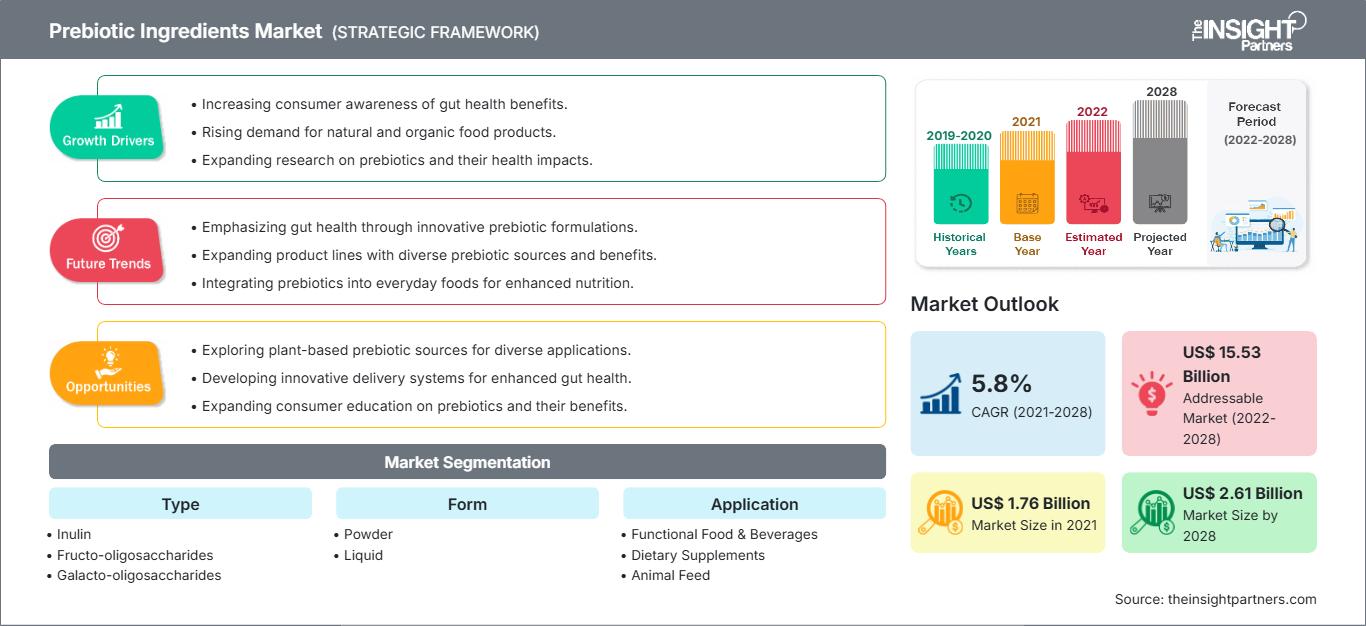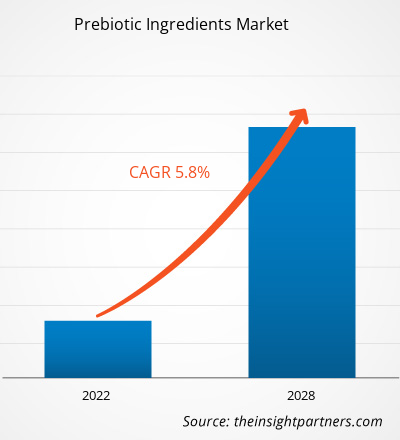[Rapporto di ricerca]Si prevede che il mercato degli ingredienti prebiotici crescerà da 1.758,40 milioni di dollari nel 2021 a 2.607,72 milioni di dollari entro il 2028; si prevede una crescita a un CAGR del 5,8% dal 2022 al 2028.
I prebiotici sono composti presenti negli alimenti che inducono la crescita o l'attività di microrganismi benefici come batteri e funghi. La fermentazione è il principale meccanismo d'azione mediante il quale i batteri benefici utilizzano i prebiotici nel colon. I prebiotici svolgono un ruolo significativo nella prevenzione sanitaria, poiché la crescente popolarità degli integratori nutraceutici ricchi di fibre tra gli appassionati di sport e gli atleti per aumentare la loro resistenza e resistenza fisica aumenta ulteriormente la domanda di ingredienti prebiotici. Pertanto, la crescente consapevolezza in materia di prevenzione sanitaria sta stimolando la crescita del mercato degli ingredienti prebiotici.
L'Asia-Pacifico ha detenuto la maggiore quota di mercato degli ingredienti prebiotici nel 2021, mentre altre regioni in via di sviluppo, come il Medio Oriente e l'Africa, dovrebbero crescere significativamente nel periodo di previsione. La crescita del mercato è attribuita all'aumento della salute intestinale e dei disturbi del sistema immunitario, associati all'aumento delle malattie digestive. I paesi asiatici stanno orientando l'adozione di alimenti e bevande sani e nutrienti per migliorare la salute intestinale. Pertanto, la propensione all'adozione di alimenti sani sta trainando la crescita del mercato degli ingredienti prebiotici.
Personalizza questo rapporto in base alle tue esigenze
Potrai personalizzare gratuitamente qualsiasi rapporto, comprese parti di questo rapporto, o analisi a livello di paese, pacchetto dati Excel, oltre a usufruire di grandi offerte e sconti per start-up e università
Mercato degli ingredienti prebiotici: Approfondimenti strategici

- Ottieni le principali tendenze chiave del mercato di questo rapporto.Questo campione GRATUITO includerà l'analisi dei dati, che vanno dalle tendenze di mercato alle stime e alle previsioni.
Potrai personalizzare gratuitamente qualsiasi rapporto, comprese parti di questo rapporto, o analisi a livello di paese, pacchetto dati Excel, oltre a usufruire di grandi offerte e sconti per start-up e università
Mercato degli ingredienti prebiotici: Approfondimenti strategici

- Ottieni le principali tendenze chiave del mercato di questo rapporto.Questo campione GRATUITO includerà l'analisi dei dati, che vanno dalle tendenze di mercato alle stime e alle previsioni.
Impatto della pandemia di COVID-19 sul mercato degli ingredienti prebiotici
La pandemia di COVID-19 ha portato sfide senza precedenti per molti settori all'inizio del 2020. Lockdown, restrizioni alle frontiere, divieti di viaggio, interruzione della produzione e altre misure di sicurezza implementate dai governi in conformità con le linee guida dell'OMS e dei ministeri della salute nazionali hanno ostacolato le attività produttive. Tuttavia, l'epidemia di COVID-19 ha avuto un impatto positivo sul mercato, poiché i consumatori erano sempre più alla ricerca di alternative naturali e più sicure per mantenersi in salute e rafforzare il proprio sistema immunitario. La domanda di integratori alimentari è aumentata drasticamente durante i primi mesi della pandemia di COVID-19. Inoltre, poiché le persone sono rimaste a casa a causa delle disposizioni governative, si sono concentrate sulla propria salute e forma fisica, stimolando la domanda di prebiotici durante la pandemia di COVID-19.
Approfondimenti di mercato
Crescente domanda di ingredienti prebiotici nel settore alimentare e delle bevande
La popolarità dei prebiotici è in aumento nel settore alimentare e delle bevande grazie alla loro applicazione in barrette nutrizionali, latticini, bevande salutari, integratori minerali, cereali per la colazione, prodotti da forno, dolciumi, alimenti verdi e alimenti per l'infanzia. Nel novembre 2018, la Kellogg's ha lanciato un nuovo cereale, con il marchio HI! Happy Inside, che include prebiotici e probiotici, come parte della sua gamma di prodotti per la digestione intestinale. Inoltre, l'inulina è ampiamente utilizzata nella lavorazione alimentare in quanto è un valido e sano sostituto di grassi e zuccheri. I principali paesi produttori di latte, come Stati Uniti, India e Cina, utilizzano i prebiotici per conferire la consistenza desiderata ai prodotti finali e realizzare latticini senza zucchero. Inoltre, il latte artificiale o gli alimenti per l'infanzia contengono vari ingredienti prebiotici, tra cui galatto-oligosaccaridi, frutto-oligosaccaridi e polidestrosio. Questi sono i fattori che guidano la crescita del mercato degli ingredienti prebiotici.
Approfondimenti basati sulla tipologia
In base alla tipologia, il mercato degli ingredienti prebiotici è segmentato in inulina, frutto-oligosaccaridi (FOS), galatto-oligosaccaridi (GOS), mannano-oligosaccaridi (MOS) e altri. Si prevede che il segmento dell'inulina registrerà la quota maggiore durante il periodo di previsione. I produttori lo utilizzano in alimenti e bevande trasformati, integratori alimentari e mangimi per animali in sostituzione di zucchero, grassi e farina. Negli Stati Uniti, nel 2018, la Food and Drug Administration ha approvato l'inulina come ingrediente di fibre alimentari per migliorare il valore nutrizionale dei prodotti alimentari trasformati. Inoltre, la crescente domanda di prodotti naturali aumenta la domanda di inulina prebiotica in tutto il mondo. La crescita del segmento dell'inulina è trainata dalla crescente applicazione in vari settori, alimentando la crescita del mercato degli ingredienti prebiotici.
Approfondimenti basati sulla forma
In base alla forma, il mercato degli ingredienti prebiotici è segmentato in polvere e liquido. Si prevede che il segmento in polvere registrerà un CAGR più elevato nel mercato durante il periodo di previsione. La forma in polvere ha semplificato la distribuzione e l'utilizzo dei prebiotici. Il vantaggio dell'utilizzo di prebiotici in polvere per l'allevamento sta guadagnando popolarità poiché i prebiotici in polvere sono accessibili e consumabili in qualsiasi fase della vita del bestiame. Inoltre, la crescente produttività di carni, uova e latte aumenta la domanda di prebiotici in polvere.
Approfondimenti basati sulle applicazioni
In base all'applicazione, il mercato degli ingredienti prebiotici è segmentato in alimenti e bevande funzionali, integratori alimentari, mangimi per animali e altri. Si prevede che il segmento degli integratori alimentari registrerà il CAGR più elevato del mercato durante il periodo di previsione. La crescente domanda di farmaci preventivi, il crescente numero di disturbi digestivi tra gli anziani e la mancanza di una dieta equilibrata probabilmente aumenteranno la domanda di prodotti nel settore degli integratori alimentari. I consumatori preferiscono sempre di più gli integratori alimentari a base di prebiotici a causa della crescente adozione di diete non salutari.
I principali attori che operano nel mercato degli ingredienti prebiotici sono BENEO GmbH; COSUCRA; DuPont Nutrition & Biosciences; Clasado Ltd.; Nexira; Ingredion Incorporated; SOLACTIS; Cargill, Incorporated; Sensus; e Roquette Frères. Questi attori sono impegnati nello sviluppo di prodotti con rischi per la salute ridotti per soddisfare le nuove tendenze dei consumatori e rispettare i quadri normativi. Sono coinvolti in fusioni e acquisizioni, espansioni aziendali e partnership per espandere la propria quota di mercato.
Informazioni regionali sul mercato degli ingredienti prebiotici
Le tendenze regionali e i fattori che influenzano il mercato degli ingredienti prebiotici durante il periodo di previsione sono stati ampiamente spiegati dagli analisti di The Insight Partners. Questa sezione illustra anche i segmenti e la geografia del mercato degli ingredienti prebiotici in Nord America, Europa, Asia-Pacifico, Medio Oriente e Africa, America meridionale e centrale.
Ambito del rapporto di mercato sugli ingredienti prebiotici
| Attributo del rapporto | Dettagli |
|---|---|
| Dimensioni del mercato in 2021 | US$ 1.76 Billion |
| Dimensioni del mercato per 2028 | US$ 2.61 Billion |
| CAGR globale (2021 - 2028) | 5.8% |
| Dati storici | 2019-2020 |
| Periodo di previsione | 2022-2028 |
| Segmenti coperti |
By Tipo
|
| Regioni e paesi coperti | Nord America
|
| Leader di mercato e profili aziendali chiave |
|
Densità degli attori del mercato degli ingredienti prebiotici: comprendere il suo impatto sulle dinamiche aziendali
Il mercato degli ingredienti prebiotici è in rapida crescita, trainato dalla crescente domanda da parte degli utenti finali, dovuta a fattori quali l'evoluzione delle preferenze dei consumatori, i progressi tecnologici e una maggiore consapevolezza dei benefici del prodotto. Con l'aumento della domanda, le aziende stanno ampliando la propria offerta, innovando per soddisfare le esigenze dei consumatori e sfruttando le tendenze emergenti, alimentando ulteriormente la crescita del mercato.

- Ottieni il Mercato degli ingredienti prebiotici Panoramica dei principali attori chiave
In evidenza nel rapporto
- Tendenze progressive del settore nel mercato degli ingredienti prebiotici per aiutare gli operatori a sviluppare strategie efficaci a lungo termine
- Strategie di crescita aziendale adottate per garantire la crescita nei mercati sviluppati e in via di sviluppo
- Analisi quantitativa del mercato degli ingredienti prebiotici dal 2022 al 2028
- Stima della domanda globale di probiotici
- Analisi delle cinque forze di Porter per illustrare l'efficacia di acquirenti e fornitori che operano nel settore
- Sviluppi recenti per comprendere lo scenario competitivo del mercato
- Tendenze e prospettive di mercato e fattori che regolano la crescita del mercato degli ingredienti prebiotici
- Assistenza nel processo decisionale evidenziando le strategie di mercato che sostengono l'interesse commerciale, portando alla crescita del mercato
- Dimensioni del mercato degli ingredienti prebiotici in vari nodi
- Panoramica dettagliata e segmentazione del mercato e dinamiche del settore dei probiotici
- Dimensione della crescita in varie regioni con promettenti opportunità di crescita
- Analisi storica (2 anni), anno base, previsione (7 anni) con CAGR
- Analisi PEST e SWOT
- Valore/volume delle dimensioni del mercato - Globale, Regionale, Nazionale
- Industria e panorama competitivo
- Set di dati Excel
Report recenti
Rapporti correlati
Testimonianze
Motivo dell'acquisto
- Processo decisionale informato
- Comprensione delle dinamiche di mercato
- Analisi competitiva
- Analisi dei clienti
- Previsioni di mercato
- Mitigazione del rischio
- Pianificazione strategica
- Giustificazione degli investimenti
- Identificazione dei mercati emergenti
- Miglioramento delle strategie di marketing
- Aumento dell'efficienza operativa
- Allineamento alle tendenze normative






















 Ottieni un campione gratuito per - Mercato degli ingredienti prebiotici
Ottieni un campione gratuito per - Mercato degli ingredienti prebiotici